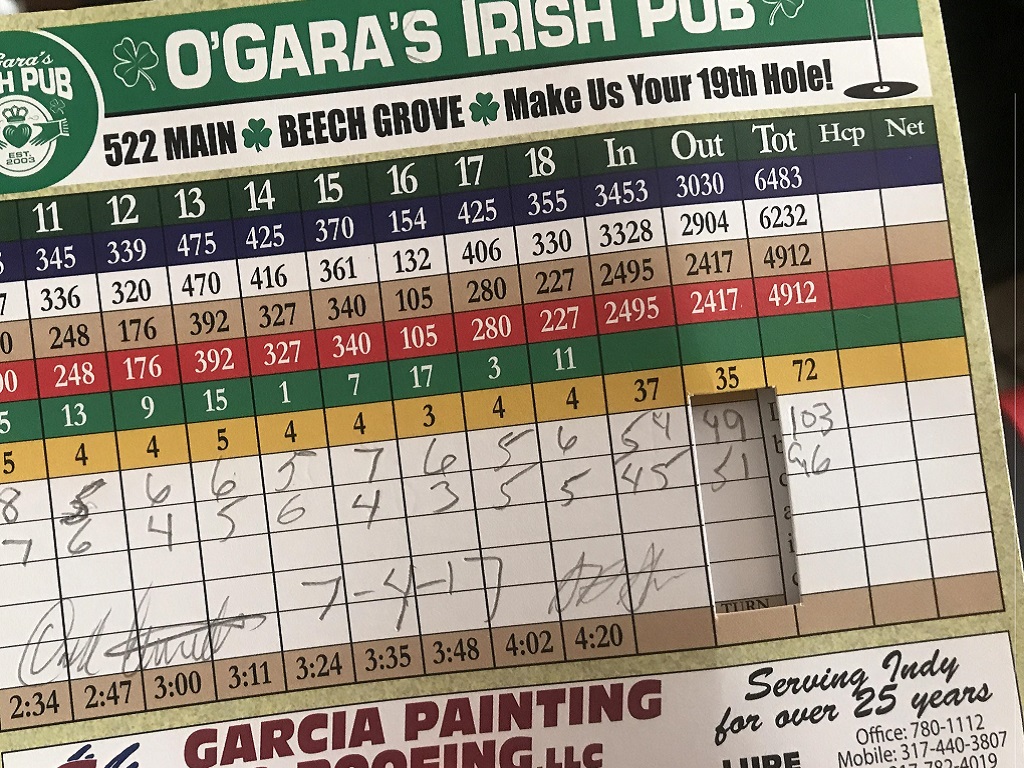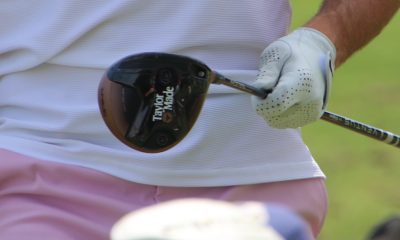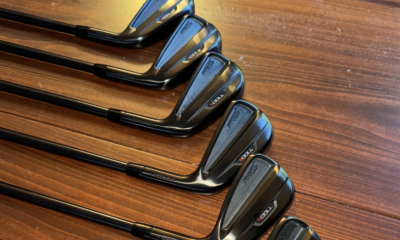Instruction
5 tips to help guarantee you’ll break 100 (or 90, or even 80!)

In my writing and teaching, I strive to constantly break from the norm, tread the paths less trodden, and help the players I coach — or people who read my articles and books — in ways that move beyond the typical. That being said, I’ve decided to finally jump on that bandwagon of clichés and write a “5 tips” type article. Why? Because these types of articles are actually quite effective, especially when the premise behind the 5 tips are so simple and effective.
Lets leave the debate over clickbait for another time, and focus here on getting you to shoot your best score ever. I’m confident these 5 tips will help you get there.
1) Stop hitting it straight
If you’re struggling to break triple digits, you probably own a two-way miss. Most of the best players in the world take one side of the course out of play by rarely hitting a straight ball. They’re typically moving the ball off the tee in a direction that favors their most natural shot shape. Now for most of us that’s a fade, and that’s a good thing, so stop fighting that fade and just play for it. There’s a reason Lee Trevino once said, “you can talk to a fade, but a hook won’t listen.” And Trevino wasn’t alone, as many of the most consistent drivers of the ball (including Hogan) played the fade, but what’s most important is to play for your most natural shot shape off the tee and stop trying to hit it straight!
2) Stop short-siding yourself
Huh? Listen to network golf coverage and you’ll hear the commentators mention how a player short-sided him or herself, but like many viewers, you likely have no idea what they’re talking about. Short-siding yourself is missing the green to the side where you have the least amount of green to work with in relation to the flag. It’s the kiss of death in golf, and something good players seldom do. Chipping (read bump-and-run type shot) is much easier, and you pay a far less severe penalty for a mishit chip than a pitch (lob shot). Aim for the long side of the flag on pins closer than 20 feet from the edge and your misses won’t keep ending up in a places where the unfortunate results of your next shot are “chunks”, “skulls”, and “chili-dips.”
3) Sleep with your sand wedge
Lots of players pitch with a pitching wedge, lob with a lob wedge, and relegate their sand wedge to only those shots they’re forced to endure from the beach. Now most of us don’t practice our short games enough to begin with, and if we’re splitting what little time we spend out there on the practice green between three (or four) different greenside wedges then we’re not likely to be very good with any of them. The sand wedge is the most versatile club in the bag, and you should learn to hit every shot inside 50 yards with it, and hit them proficiently, before you branch out to different clubs.
I grew up with nothing but an old Cobra Trusty Rusty 56-degree sand wedge that I learned to hit from every conceivable lie and situation and I knew exactly what I could do with it and what I couldn’t. Find that one club and practice with it until you know and trust your short game with it implicitly, and you’ll be surprised at how much pressure that ends up taking off your long game.
4) Quit “hitting” your putts
If you can’t break 100, chances are you don’t putt very well, and if you don’t, you likely have poor distance control. Most people who struggle to control their distances with the putter, “hit” their putts, they don’t “stroke it” or “roll it”. “Hitting” a putt is the inevitable result of a putting stroke that is too small for a given distance. One thing I consistently preach with my Academy students is the bigger the putt the bigger the putting stroke. If you’re hitting it progressively harder as you get farther and farther from the hole, try instead to let that stroke get progressively longer, and watch how much more often that first putt rolls up to within tap-in range.
5) Start closer to the hole
There’s only one reason the average men’s handicap in this country hovers around 18 while the average woman’s around 33, but it’s a very big one. Distance! The average woman hits the ball 140 yards off the tee while the average man hits it 210. Over the course of 18 holes, that’s about 1300 yards, and it doesn’t even account for the approaches. Research has been done which suggests that, in order for players to be able to hit most greens in regulation, they should play from tees that are about 30 times their average drive. That would put most women at tees that measure 4,200 yards, and most men at 6,300 yards.
Sadly, most clubs aren’t offering tees at 4,200 yards, but we should be, and until then we should all be realistic about how far we hit the ball off the tee, multiply that number by 30, and find the closest set of tees we can to that number and play from there. And if we do that, we not only might finally break 100, and speed up the pace of play at the same time, but we just might have a bit more fun in the process!
So there’s your five tips! And now that I’ve guaranteed you’ll all be breaking that milestone number in your game, I expect the editors of big-time golf magazine publications to come knocking on my inbox for that 101st cliché cover story. Hope it helps!
image credit: sacrededge on reddit
- LIKE207
- LEGIT12
- WOW3
- LOL4
- IDHT1
- FLOP2
- OB2
- SHANK24
Instruction
The Wedge Guy: The easiest-to-learn golf basic

My golf learning began with this simple fact – if you don’t have a fundamentally sound hold on the golf club, it is practically impossible for your body to execute a fundamentally sound golf swing. I’m still a big believer that the golf swing is much easier to execute if you begin with the proper hold on the club.
As you might imagine, I come into contact with hundreds of golfers of all skill levels. And it is very rare to see a good player with a bad hold on the golf club. There are some exceptions, for sure, but they are very few and very far between, and they typically have beat so many balls with their poor grip that they’ve found a way to work around it.
The reality of biophysics is that the body moves only in certain ways – and the particulars of the way you hold the golf club can totally prevent a sound swing motion that allows the club to release properly through the impact zone. The wonderful thing is that anyone can learn how to put a fundamentally sound hold on the golf club, and you can practice it anywhere your hands are not otherwise engaged, like watching TV or just sitting and relaxing.
Whether you prefer an overlap, interlock or full-finger (not baseball!) grip on the club, the same fundamentals apply. Here are the major grip faults I see most often, in the order of the frequency:
Mis-aligned hands
By this I mean that the palms of the two hands are not parallel to each other. Too many golfers have a weak left hand and strong right, or vice versa. The easiest way to learn how to hold the club with your palms aligned properly is to grip a plain wooden ruler or yardstick. It forces the hands to align properly and shows you how that feels. If you grip and re-grip a yardstick several times, then grip a club, you’ll see that the learning curve is almost immediate.
The position of the grip in the upper/left hand
I also observe many golfers who have the butt of the grip too far into the heel pad of the upper hand (the left hand for right-handed players). It’s amazing how much easier it is to release the club through the ball if even 1/4-1/2″ of the butt is beyond the left heel pad. Try this yourself to see what I mean. Swing the club freely with just your left hand and notice the difference in its release from when you hold it at the end of the grip, versus gripping down even a half inch.
To help you really understand how this works, go to the range and hit shots with your five-iron gripped down a full inch to make the club the same length as your seven-iron. You will probably see an amazing shot shape difference, and likely not see as much distance loss as you would expect.
Too much lower (right) hand on the club
It seems like almost all golfers of 8-10 handicap or higher have the club too far into the palm of the lower hand, because that feels “good” if you are trying to control the path of the clubhead to the ball. But the golf swing is not an effort to hit at the ball – it is a swing of the club. The proper hold on the club has the grip underneath the pad at the base of the fingers. This will likely feel “weak” to you — like you cannot control the club like that. EXACTLY. You should not be trying to control the club with your lower/master hand.
Gripping too tightly
Nearly all golfers hold the club too tightly, which tenses up the forearms and prevents a proper release of the club through impact. In order for the club to move back and through properly, you must feel that the club is controlled by the last three fingers of the upper hand, and the middle two fingers of the lower hand. If you engage your thumbs and forefingers in “holding” the club, the result will almost always be a grip that is too tight. Try this for yourself. Hold the club in your upper hand only, and squeeze firmly with just the last three fingers, with the forefinger and thumb off the club entirely. You have good control, but your forearms are not tense. Then begin to squeeze down with your thumb and forefinger and observe the tensing of the entire forearm. This is the way we are made, so the key to preventing tenseness in the arms is to hold the club very lightly with the “pinchers” — the thumbs and forefingers.
So, those are what I believe are the four fundamentals of a good grip. Anyone can learn them in their home or office very quickly. There is no easier way to improve your ball striking consistency and add distance than giving more attention to the way you hold the golf club.
More from the Wedge Guy
- The Wedge Guy: Golf mastery begins with your wedge game
- The Wedge Guy: Why golf is 20 times harder than brain surgery
- The Wedge Guy: Musings on the golf ball rollback
- LIKE85
- LEGIT13
- WOW6
- LOL1
- IDHT0
- FLOP4
- OB1
- SHANK8
Instruction
Clement: Stop ripping off your swing with this drill!

Not the dreaded headcover under the armpit drill! As if your body is defective and can’t function by itself! Have you seen how incredible the human machine is with all the incredible feats of agility all kinds of athletes are accomplishing? You think your body is so defective (the good Lord is laughing his head off at you) that it needs a headcover tucked under the armpit so you can swing like T-Rex?
- LIKE0
- LEGIT2
- WOW2
- LOL0
- IDHT0
- FLOP0
- OB0
- SHANK2
Instruction
How a towel can fix your golf swing

This is a classic drill that has been used for decades. However, the world of marketed training aids has grown so much during that time that this simple practice has been virtually forgotten. Because why teach people how to play golf using everyday items when you can create and sell a product that reinforces the same thing? Nevertheless, I am here to give you helpful advice without running to the nearest Edwin Watts or adding something to your Amazon cart.
For the “scoring clubs,” having a solid connection between the arms and body during the swing, especially through impact, is paramount to creating long-lasting consistency. And keeping that connection throughout the swing helps rotate the shoulders more to generate more power to help you hit it farther. So, how does this drill work, and what will your game benefit from it? Well, let’s get into it.
Setup
You can use this for basic chip shots up to complete swings. I use this with every club in my bag, up to a 9 or 8-iron. It’s natural to create incrementally more separation between the arms and body as you progress up the set. So doing this with a high iron or a wood is not recommended.
While you set up to hit a ball, simply tuck the towel underneath both armpits. The length of the towel will determine how tight it will be across your chest but don’t make it so loose that it gets in the way of your vision. After both sides are tucked, make some focused swings, keeping both arms firmly connected to the body during the backswing and follow through. (Note: It’s normal to lose connection on your lead arm during your finishing pose.) When you’re ready, put a ball in the way of those swings and get to work.

Get a Better Shoulder Turn
Many of us struggle to have proper shoulder rotation in our golf swing, especially during long layoffs. Making a swing that is all arms and no shoulders is a surefire way to have less control with wedges and less distance with full swings. Notice how I can get in a similar-looking position in both 60° wedge photos. However, one is weak and uncontrollable, while the other is strong and connected. One allows me to use my larger muscles to create my swing, and one doesn’t. The follow-through is another critical point where having a good connection, as well as solid shoulder rotation, is a must. This drill is great for those who tend to have a “chicken wing” form in their lead arm, which happens when it becomes separated from the body through impact.
In full swings, getting your shoulders to rotate in your golf swing is a great way to reinforce proper weight distribution. If your swing is all arms, it’s much harder to get your weight to naturally shift to the inside part of your trail foot in the backswing. Sure, you could make the mistake of “sliding” to get weight on your back foot, but that doesn’t fix the issue. You must turn into your trial leg to generate power. Additionally, look at the difference in separation between my hands and my head in the 8-iron examples. The green picture has more separation and has my hands lower. This will help me lessen my angle of attack and make it easier to hit the inside part of the golf ball, rather than the over-the-top move that the other picture produces.


Stay Better Connected in the Backswing
When you don’t keep everything in your upper body working as one, getting to a good spot at the top of your swing is very hard to do. It would take impeccable timing along with great hand-eye coordination to hit quality shots with any sort of regularity if the arms are working separately from the body.
Notice in the red pictures of both my 60-degree wedge and 8-iron how high my hands are and the fact you can clearly see my shoulder through the gap in my arms. That has happened because the right arm, just above my elbow, has become totally disconnected from my body. That separation causes me to lift my hands as well as lose some of the extension in my left arm. This has been corrected in the green pictures by using this drill to reinforce that connection. It will also make you focus on keeping the lead arm close to your body as well. Because the moment either one loses that relationship, the towel falls.


Conclusion
I have been diligent this year in finding a few drills that target some of the issues that plague my golf game; either by simply forgetting fundamental things or by coming to terms with the faults that have bitten me my whole career. I have found that having a few drills to fall back on to reinforce certain feelings helps me find my game a little easier, and the “towel drill” is most definitely one of them.
- LIKE12
- LEGIT2
- WOW2
- LOL0
- IDHT0
- FLOP2
- OB0
- SHANK8
-

 19th Hole1 week ago
19th Hole1 week agoDave Portnoy places monstrous outright bet for the 2024 Masters
-

 19th Hole2 weeks ago
19th Hole2 weeks agoThings got heated at the Houston Open between Tony Finau and Alejandro Tosti. Here’s why
-

 19th Hole1 week ago
19th Hole1 week agoTiger Woods arrives at 2024 Masters equipped with a putter that may surprise you
-

 19th Hole2 weeks ago
19th Hole2 weeks agoReport: Tiger Woods has ‘eliminated sex’ in preparation for the 2024 Masters
-

 19th Hole3 days ago
19th Hole3 days agoTwo star names reportedly blanked Jon Rahm all week at the Masters
-

 19th Hole3 days ago
19th Hole3 days agoNeal Shipley presser ends in awkward fashion after reporter claims Tiger handed him note on 8th fairway
-

 19th Hole2 weeks ago
19th Hole2 weeks agoAddiction, spinal fusion, and scam artists – Everything Anthony Kim revealed in candid interview with David Feherty
-

 19th Hole2 weeks ago
19th Hole2 weeks agoAnthony Kim says doctors told him that he ‘may not have much time left’ ahead of LIV return

























Larry Covey
Sep 12, 2018 at 2:08 am
The PGA pros play to a factor of 25 or lower! Most pros drive the ball 300+ and using a 25 factor equals 7500 yds! For me, being 77 years of age and hitting my driver 225 yds, my factor would be 5625 yds! Pretty hard to find courses offering men’s tees less than 6000 yards, raising my factor close to 27! I normally play 6100 to 6350 yds and carry a high single digit hdcp. I hit my #4 hybrid 200 yds, pros hit their 7 irons the far!
So using that as the average men’s factor, (27), the pros SHOULD be playing courses at 8100 yds or more!
joro
Sep 11, 2018 at 10:54 am
Another great article, Truth is most people that play Golf have no ability to do any of that and play for fun until they get an overload of articles telling them how to swing, hook it, hit it solid, and a million other things to think about, get frustrated and quit. And the great gurus keep on writing and confusing more people.
Bob Jones
Sep 10, 2018 at 1:58 pm
(5) The PGA Tour presents courses that average 25 times the average drive, the LPGA 26 times. 30 times is too long for recreational golfers.
Instead, I use this rule: add together the distance of my average drive and the carry distance of my average 7-iron. Half the par 4s should be this distance or less.
Aztec
Sep 10, 2018 at 2:54 pm
Excellent idea, makes a lot more sense than suggesting 30 times average driving distance. Too bad it’s not backed by ‘research’ like Mike Dowd’s statement.
Michael
Sep 10, 2018 at 7:36 am
Mike – Do you have a video explaining 2) Stop short-siding yourself?
DaveyD
Sep 9, 2018 at 11:56 pm
Good article- I try to focus on a few other things- get as many greens in regulation as I can; avoid the penalty stroke situation by staying in the fairway; no three-putts. Not as successful as I would like, but I’m down to a 14 handicap.
Richard Douglas
Sep 9, 2018 at 11:00 pm
6. Stop lying to yourself about your carry distances. Seriously. You don’t hit it nearly as far as you think. Also, on most holes, it’s better to miss long than short. Short is where they put most bunkers and water hazards. Sure, you sometimes see these in the back, or drop-offs back there that are horrible. So change your approach there. Better yet, aim to the center of almost all greens, unless there is a specific reason to aim long or short. Besides, it feels awful and weak to come up short, but missing long is almost a “good” miss. Slammed it!
BigHitter
Sep 9, 2018 at 11:37 pm
I increase my carry distance by 20 yards annually with each new driver model. I’m projecting 300 yard carry in 5 years at this rate of improvement.
Aztec
Sep 9, 2018 at 9:24 pm
So, if someone drives 250 yds on average they should play tees at around 7,500 yds? And the big hitters at 300 yds should play tees at 9,000 yds?
Really, this is what ‘research’ is suggesting? Your credibility is very tenuous.
Jason
Sep 10, 2018 at 9:55 am
I agree, I think a factor of 25 is much more reasonable. For people hitting the ball 250 yards that would be 6250, which is about what I do. For people hitting it 210 yards that would be 5300 yards.
Since you are talking average handicaps and giving them a factor to use for what tee boxes to use 25 makes a lot more sense than 30.
Now you could say “I’m a scratch golfer who hits it 250 yards. Playing from 6250 is too easy.” Well congrats and this general reference wasn’t made for you. It was made for the group of 15-20 handicaps in the group in front of you that are playing from the tips while you complain about the round already taking 5 hours while you are standing on the 15th tee.
GMR
Sep 10, 2018 at 11:52 am
Haha I was wondering the exact same thing! I’m a long hitter averaging about 290 off the tee, and thought it might be fun to play the back 9 at Kiawah Ocean Course off the tips at around 4k yards (for 9 holes)… Let’s just say that while that was an interesting experience I won’t be doing that again anytime soon (or ever). And yet by Mr. Dowd’s math that course was actually TOO SHORT for me!!!
Josh Leyes
Sep 10, 2018 at 1:34 pm
Agreed! Not sure where he got that “research” from, but for golfers to hit the most greens in regulation possible, they should play from the most forward tees possible. Duh. I know a lot of guys who hit it 250+ (myself included) who struggle to hit greens on some days playing courses 6300-6500 yards. Not a well thought out point at all by Mike Dowd.
Jim
Sep 9, 2018 at 3:03 pm
They arnt whats wrong here… you are. Go back to bedding your sister and collecting confederate flags and dip cups.
Tom
Sep 9, 2018 at 2:00 pm
Mike…. you are talking to the 1% of golfers who are committed to the game of golf. These people will make an effort to improve, while the remainder only play golf for yuks and fun. I suspect you already know that.